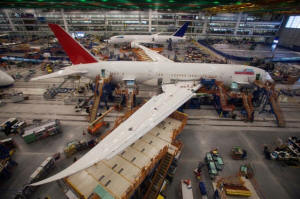|
Boeing, machinists face off over union at
South Carolina plant
 Send a link to a friend
Send a link to a friend
 [February 13, 2017]
By Alwyn Scott and Harriet McLeod [February 13, 2017]
By Alwyn Scott and Harriet McLeod
NEW YORK/NORTH CHARLESTON, S.C. (Reuters) -
Boeing Co faces its first union vote on Wednesday at its aircraft
factory in South Carolina, a high-profile test for organized labor in
the nation's most strongly anti-union state.
The world's largest planemaker is running a hardball campaign against
the International Association of Machinists and Aerospace Workers (IAM),
which is trying to organize about 3,000 workers at one of two plants
where Boeing makes 787 Dreamliners. The other, in Washington state, has
long been unionized by the IAM.
"It would be a major, major win for the machinists if they got this,"
said Arthur Schwartz, an independent consultant who worked in labor
relations at General Motors Co for two decades and does not represent
either side.
Opposition is strong in South Carolina, which is one of 28 states that
does not require workers to join a union, and has the lowest proportion
of union workers, at 1.6 percent, according to the Bureau of Labor
Statistics. New York is the highest with 23.6 percent.
The IAM canceled a voted at the Boeing plant in April 2015 after it
claimed there was "political interference" from state officials and
"misinformation" spread among workers. Former Governor Nikki Haley, who
is now U.S. ambassador to the United Nations, was among those who voiced
strong opposition to the union in 2015.
Boeing told Reuters in an emailed statement that in the current campaign
it has hired the same lawyer who helped it defend against the IAM
previously.

Videos and posts on Boeing's web and social media sites portray the IAM
as a "divisive" force that fights with management, makes promises it
cannot keep and leads workers into strikes.
In one video on Boeing's site a production manager at Boeing South
Carolina describes the tension and lost income from striking twice while
he worked as a union machinist in Renton, Washington.
"There was times where I wondered where I was going to be able to feed
my kid," said the manager, Daniel Mihalic, over ominous music. "Please
vote 'no' on February 15."
Boeing invested $750 million to build the South Carolina factory after a
costly machinists strike in 2008 that shut down production in
Washington. It spent $1 billion more to expand aircraft engine casing
and interiors production. Its employment in the state peaked at 8,400 in
2014 and has since fallen by 10 percent.
The company said factory officials were unavailable for comment because
"their time is committed to ensuring our teammates understand the voting
process, the realities of union representation and the advantages of a
nonunion environment."
Boeing's videos are being aired on local TV stations - including during
the Super Bowl - and also shown in break rooms at the plant, mechanic
Elliott Slater, 57, who supports the union, said in an interview.
When the IAM filed for a vote with the National Labor Relations Board
last month, Slater and others said, a display of diapers and clothing
appeared in a break room. "The goods on display would cost your family
$800," a sign said. "You have better things to do with your money than
pay union dues."
[to top of second column] |

Workers at South Carolina Boeing work on a 787 Dreamliner for Air
India at the plant's final assembly building in North Charleston,
South Carolina December 19, 2013. REUTERS/Randall Hill/File Photo

Slater said workers want higher wages and more certainty about their
shifts, which change often. The IAM said hourly workers in South
Carolina earn about 36 percent less than their counterparts in
Washington.
"We're tired of the back-and-forth, the constant inundation of the
anti-union rhetoric," Slater said. "We're just ready to vote."
STANDARD PLAY BOOK
Boeing's campaign follows the usual "union avoidance" play book used
by many manufacturers, labor experts said.
That contrasts with the relationship Detroit automakers and the
United Auto Workers union have forged. After years of struggle, the
companies decided bad union relations were unproductive, former
labor negotiators for Ford Motor Co and GM said.
"Ford was the last to get organized of the Big Three, but we were
the first to understand that we had a business partner in the UAW
and we were going to work with them. We're not going to fight them,"
said Marty Mulloy, who served for nine years as Ford's vice
president of labor affairs, retiring in 2013.
Ford found negative campaigns did not work, he said, and would not
use one today.
"My experience has been working collaboratively with unions yields
better results," Mulloy said. Going negative "just takes the
animosity to another level. You take it from, 'I disagree with you
on principle,' to 'I'm going to hire some people to try to discredit
you and your institution.'"
Jon Holden, president of IAM District 751, which represents more
than 35,000 union workers at Boeing in Washington state, said
members are sending videos and posting words of support on Boeing's
South Carolina Facebook page. But they have not paid much attention
to Boeing's counter campaign, having seen such tactics before.

"Personally, I hate seeing this in any anti-union campaign," he
said. "I like people having a free choice on what they want to do,
being able to ask questions and not seeing intimidation."
(Reporting by Alwyn Scott and Harriet McLeod; editing by Diane
Craft)
[© 2017 Thomson Reuters. All rights
reserved.]
Copyright 2017 Reuters. All rights reserved. This material may not be published,
broadcast, rewritten or redistributed. |